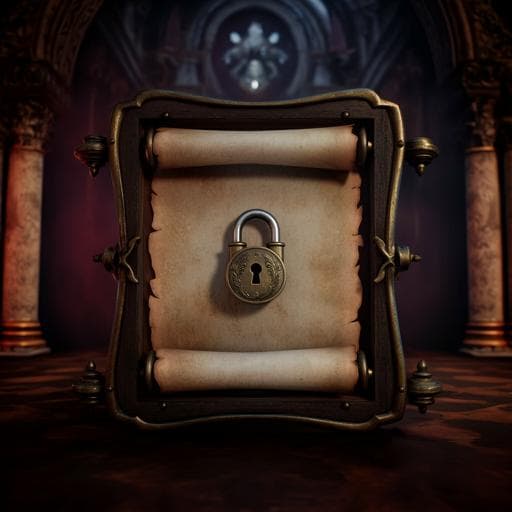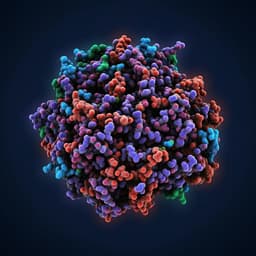
Humanities
Unlocking history through automated virtual unfolding of sealed documents imaged by X-ray microtomography
J. Dambrogio, A. Ghassaei, et al.
This groundbreaking research conducted by Jana Dambrogio and her team unveils a fully automatic computational method that reconstructs and unfolds volumetric scans of locked letters, revealing their hidden contents and intricate crease patterns, while maintaining vital letterlocking evidence. This innovative approach has even deciphered an unopened Renaissance letter for the first time!
~3 min • Beginner • English
Introduction
The study addresses how to non-invasively open and read sealed historical letters that were secured using complex “letterlocking” techniques, without physically damaging the artifacts. Before mass-produced envelopes, letters were folded and locked to provide tamper evidence and security, leaving crease marks and seals that encode their construction. Conventional archival practice often requires cutting open sealed letters, destroying this evidence. Leveraging a unique cache of 577 unopened letters from the 17th-century Brienne Collection—within a trunk of undelivered post that preserves intact examples—the authors seek to develop an automated, computational method to virtually reconstruct folded letters from volumetric X-ray microtomography (XMT) scans. The purpose is twofold: to read contents while preserving material and security evidence, and to validate and extend a systematization of letterlocking techniques derived from studying 250,000 historical letters. The work has importance for cultural heritage conservation, the history of communications security, and the broader recovery of texts from sealed or fragile artifacts.
Literature Review
Prior work has used X-ray microtomography and related imaging to recover text from sealed or damaged documents, focusing primarily on scrolls, books, and items folded only once or twice. Methods often rely on 2D cross-sectional analyses, assumptions of layer congruence, user-defined contours for initialization, and semi-manual processes, with challenges when substrates are heterogeneous or highly warped. Studies have demonstrated virtual unwrapping of artifacts such as the En-Gedi scroll and Herculaneum papyri and extraction of book pages, but intricate folding topologies like letterlocked packets remained largely unaddressed. Existing mesh parameterization techniques for texture mapping emphasize distortion minimization but commonly assume hole-free disk-topology meshes. The present work advances the field by proposing a fully 3D, fully automatic pipeline that does not assume prior knowledge of fold orientation or topology, avoids user-initialized contours, and targets complex, multi-folded letters to both read their contents and analyze their crease patterns for security mechanics.
Methodology
The virtual unfolding pipeline comprises five automated stages operating on high-contrast time delay integration X-ray microtomography (XMT) data:
1) XMT scanning: Acquire a volumetric dataset encoding material density; inks with higher-Z elements (iron, copper, mercury) appear as bright, high-density regions. Raw data are scaled and quantized into an 8-bit grayscale voxel volume.
2) Segmentation: Identify and separate layers of the writing substrate from air and surrounding materials. Feature points on the medial surface of paper are detected with subvoxel precision using ridge detection and local geometric cues (orientation, first and second partial derivatives). Local substrate thickness is estimated to filter out regions exceeding expected thickness (e.g., compressed multiple layers, adhesives, wax, pounce sand, or scan artifacts). Remaining feature points are linked into a 3D mesh; initial coverage typically spans ~50–80% of the packet and is fragmented into many connected components (~10,000–20,000), from small fragments (~50 vertices) to very large meshes (up to ~20 million vertices).
3) Flattening: Compute a distortion-minimizing 2D embedding of each 3D connected component, representing the unfolded state. Vertices are mapped from R^3 to R^2 by seeding a triangle and incrementally adding vertices under orientation and distance constraints while minimizing a spring-energy objective to reduce edge-length distortion. Each component is flattened independently and lacks a common 2D reference frame.
4) Hybrid mesh propagation: Simultaneously repair segmentation discontinuities in 3D and 2D and merge flattened components into a common 2D frame. The mesh is grown into regions lacking reliable features while optimizing 3D/2D vertex positions to enforce developability, inter-layer separation, and fidelity to XMT data. As components approach in 3D, rigid transformations align their 2D embeddings for successive merging. A key insight uses distance metrics: points close in 3D but far in 2D (different layers) should not be connected; this informs correct topology during growth and merging.
5) Texturing and crease mapping: Generate a 2D image of the unfolded letter by mapping destination pixels onto 3D voxels via the 2D–3D correspondence, sampling grayscale intensities at subvoxel positions (yielding a result comparable to ~668 dpi at current scan resolution). Optionally offset sampling along surface normals; zero offset gave best results for these papers. A crease-pattern image is computed by mapping mean curvature from the 3D mesh to 2D: sign indicates crease direction (mountain/red or valley/blue) and saturation encodes curvature magnitude, revealing sharp versus gentle folds and additional geometric features like buckling. Validation included comparing the unfolded, textured image of an opened letter (DB-2040) to a photograph, demonstrating low geometric distortion across creases.
Key Findings
- Developed a fully automatic pipeline to virtually unfold sealed, letterlocked packets from XMT scans, producing: (1) 3D folded reconstruction, (2) 2D unfolded reconstruction, (3) a 3D–2D mapping, (4) legible unfolded text images, and (5) crease-pattern images that preserve locking evidence.
- Successfully applied to four letters from the Brienne Collection: DB-1538, DB-1627, DB-1976 (unopened), and DB-2040 (opened test case). For letters with separate paper locks (DB-1976, DB-2040), primary substrate and lock were reconstructed as separate pieces.
- First reading of the contents of sealed letter DB-1627 (dated July 31, 1697): a request by Jacques Sennacques to Pierre Le Pers for a certified copy of a death notice.
- Validation: For DB-2040, the virtually flattened, textured image shows low geometric distortion compared with a photograph, including across creases.
- Crease-pattern mapping reveals internal folding mechanics, enabling step-by-step reconstruction of the locking sequence and preservation of tamper-evidence features.
- Letterlocking systematization confirmed and refined without opening artifacts. Using virtual unfolding, categories can be assigned with confidence to unopened letters (e.g., DB-1976 determined to be LC15 low security rather than a high-security alternative suggested by exterior inspection).
- Brienne Collection quantitative breakdown (Table 1): 3148 total items; 865 items not counted as letterlocking; 577 unopened items; 1706 items counted as opened letterlocking (1701 opened, 5 partially opened). Of the 1706, 1475 were assigned to one LC category; 231 were assigned as either-or categories.
- Letterlocking formats among 1706 opened letterlocked items (Table 2A): 4R=58; 4RW=1; 4RXW=1473; 4RT=139; 45=22; 4SD=10; 5P=3.
- Letterlocking categories among the 1475 single-category assignments (Table 2B): LC1 Zero=41; LC2 Zero=3; LC5 Low=760; LC6 Low=612; LC13 Low=1; LC14 Low=1; LC15 Low=6; LC16 Low=3; LC25 Zero=1; LC29 Low=46; LC30 Low=1. LC5 and LC6 dominate, indicating a shift toward “fold and adhere” methods resembling modern envelopes.
- Texturing resolution comparable to ~668 dpi; crease mapping visualizes mountain/valley folds and curvature magnitude.
- Generality: Approach is unbiased to fold orientation/topology, requires no prior fold count or user-defined contours, and scales across substrate thicknesses.
Discussion
The results demonstrate that complex, multi-folded, letterlocked documents can be reconstructed and read non-invasively, preserving material evidence critical to understanding historical communication security. By providing both unfolded text imagery and crease-pattern maps with a rigorous 3D–2D correspondence, the method addresses the core research goals: accessing contents while retaining tamper-evident features and validating letterlocking mechanics. Validation against an opened exemplar confirms geometric fidelity, and successful separation of paper locks underscores the technique’s sensitivity to document structure. The pipeline’s fully 3D, automatic nature, independence from fold orientation and topology, and elimination of user-initialized contours broaden applicability beyond prior scroll/book-focused methods. Historically, the quantitative categorization (dominance of LC5/LC6) supports evolving security practices and enables metadata standardization for archives. Conservation-wise, virtual unfolding allows sealed artifacts to remain intact, transforming access models for heritage collections and enabling large-scale, data-driven studies of epistolary security across time and cultures.
Conclusion
This work introduces an end-to-end, fully automatic virtual unfolding pipeline that unlocks sealed letterlocked documents imaged by XMT, yielding legible text and detailed crease evidence without physically opening artifacts. It validates and refines a comprehensive letterlocking categorization framework and demonstrates applicability across varied folding sequences, including separate paper locks. The approach offers significant benefits to cultural heritage conservation, digital humanities, and the study of historical security practices, enabling sealed materials to be studied intact at scale. Future research directions include: enhancing robustness and global consistency in segmentation/flattening; incorporating user-in-the-loop tools where needed; improving handling of warped or damaged substrates; exploring alternative imaging modalities and post-processing for low-contrast inks; integrating advanced global parameterization methods for meshes with holes; and expanding deployment to large unopened collections (e.g., Prize Papers) for comprehensive, data-driven analyses.
Limitations
- Segmentation challenges from scan artifacts: dense ink, adhesives, sealing wax (especially leaded or metal-laden seals), and pounce can blur or obscure layer boundaries; angled paper relative to slices can appear artificially thick.
- Global consistency: Local rules in segmentation/flattening can accumulate errors, causing localized distortion in the 2D embedding and incomplete or incorrect merging of connected components; missing or mispositioned regions occurred in DB-1538 and DB-1627.
- Ink contrast: Carbon-based inks may have low or no contrast at current XMT settings, limiting readability; requires alternative imaging modalities or post-processing to enhance subtle density/structural differences.
- Warped/damaged documents: The incremental flattening assumes limited warping; heavily warped, delaminated, or heterogeneous substrates may not map well without introducing unacceptable distortion.
- Topological assumptions in potential improvements: Many global parameterization techniques assume disk-topology meshes (no holes), complicating direct integration.
- Reproducibility sensitivity: Outputs depend on scan data and code versions; changes to inputs or parameters affect results, necessitating metadata tracking and provenance visualization.
- Avoided leaded/shellac seals with metal strands in this study, limiting generalizability to such cases.
Related Publications
Explore these studies to deepen your understanding of the subject.







